How to Travel to Libya in 2024
0 View
Share this Video
- Publish Date:
- August 7, 2024
- Category:
- HOW TO -
- Video License
- Standard License
- Imported From:
- Youtube
Tags
Sponsored Area
TODAY'S ADVENTURE
How to Travel to Libya in 2024>Wanna travel to Libya with Against the Compass?
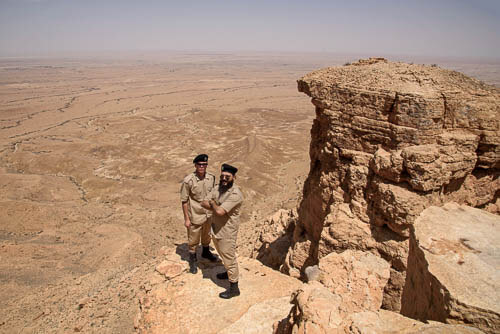
Join a group of like-minded travelers in our next scheduled tour in Libya on:
October 26th to November 1st, 2024learn moreThis is the most complete and up-to-date Libya travel guide available on the internet.
Libya is a surprising country indeed.
Home to Leptis Magna and Sabratha, Libya has outstanding, world-class Roman ruins, sitting on the Libyan coast.
From 1911 to 1951, the country was an Italian colony, the heritage of which is still very visible, not only in the architecture that dominates the center of Tripoli, but also in the somehow sophisticated way Libyans drink their cappuccino.
Except for a tiny part of the – today inaccessible – eastern coast, Libya is an utterly massive, barely populated desert, filled with ancient Berber, caravan towns like Gadhames, located more than 600km from Tripoli.
Today, however, Libya has become a failed state struggling to put an end to an armed conflict that has been ongoing since 2011, preventing travelers from venturing into the most off the beaten track country in the whole Mediterranean.
However, with proper planning and research, anyone can travel to Libya safely.
This guide contains endless Libya travel tips that will show you how.
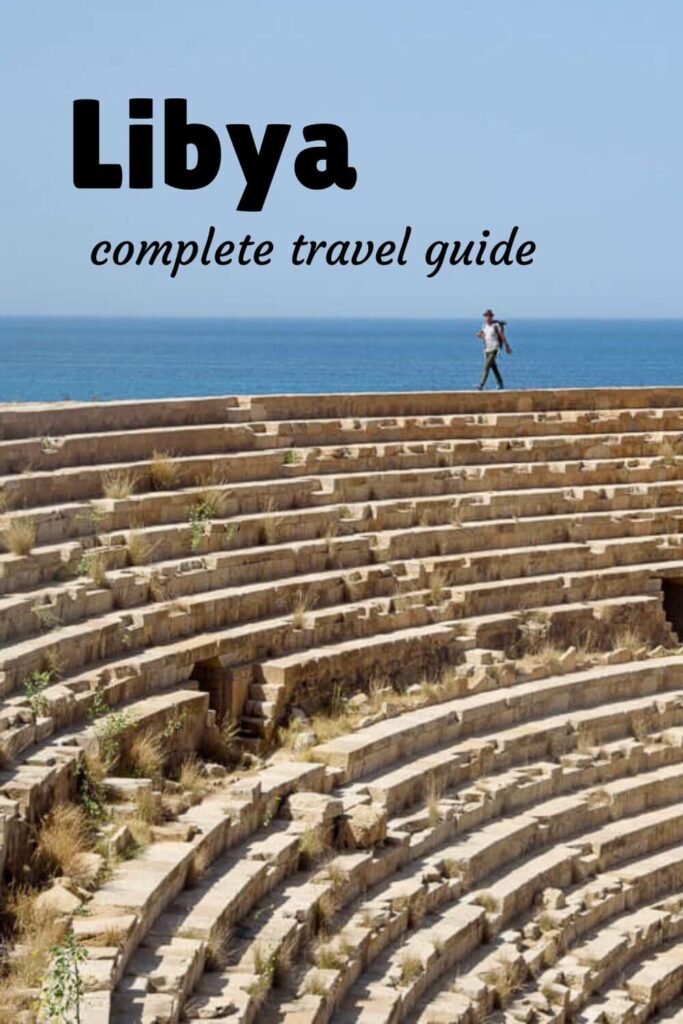
In this Libya travel guide, you’ll find:
Table of ContentsLibya todaySafetyHow to get a visaTravel InsuranceIndependent travel in LibyaToursGetting inBest time to visitTop experiencesInternet & connectivityBudget & MoneyGetting aroundCultureLibyan cuisineWhere to staySolo female travelMore informationour recommended travel insurance for Libya
IATI Insurance is one of the very few that covers travel in Libya.GET 5% DISCOUNT HERE

Libya today: what is it like to travel to Libya?
In 2011, following the Arab Spring in neighbouring Tunisia and Egypt, a set of peaceful protests against an absolute Libyan dictator, Muammar Gaddafi, escalated into a bloody armed conflict between the rebels and Gaddafi’s local forces.
One year later, Gaddafi was defeated, captured, and killed, putting an end to more than 40 years of dictatorship.
For the first time ever, Libyans were able to foresee a bright, beautiful future but, unfortunately, the same people who wanted to overthrow Gaddafi, claiming to favor democracy, began to fight each other over power and wealth, dividing the country into different regions controlled by different militias.
A second civil war began, and on and off conflicts continued until the country officially split into two main regions, ruled by two different, independent Governments: West Libya, with Tripoli as the capital, and East Libya, with Benghazi as the main city.
However, in October 2020, exhausted from a pointless civil war, both Governments signed a permanent ceasefire and promised to hold elections, but they have been continuously postponed ever since.
Today, the peace agreement is still valid, but that doesn’t avoid the occasional clashes between the two Governments, and their permanent disagreements over power, like happened in May 2022.
Tourists can travel to Libya now, but your visa will only be valid for travel in the Western part of Libya because the Eastern Government doesn’t recognize it.
Update 2024: East Libya is now open and your regular tourist visa for Libya will be valid for the eastern part as well.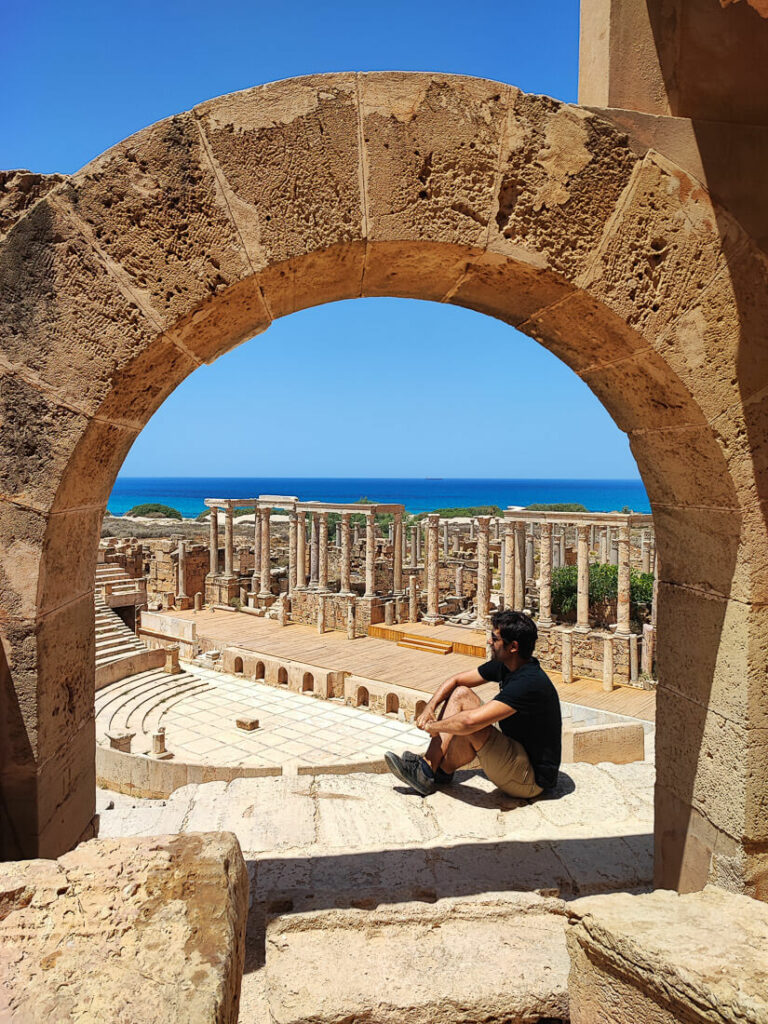
When visiting Libya, don’t miss the theater found in Leptis and Magna

Is it safe to travel to Libya?
By far, safety is the number 1 concern for people wanting to visit Libya, which is kind of understandable, since the media has been showing nothing but years and years of conflict.
As previously mentioned, a peace agreement was signed between both West and East Governments back in 2020 and, except for a few occasional clashes between the Government forces – where civilians are not targeted – traveling to the West part Libya is mostly safe nowadays.
All Libyans will tell you that today, traveling to Libya is completely safe and as long as the money coming from oil – Libya is an oil-rich country – keeps flowing through both East and West, it will remain so, or that’s what many locals Libyans believe.
My personal experience when I went to Libya
From Afghanistan to Syria and Iraq, one can really feel that you are in a conflict or post-war country but for some reason, not in Libya.
On the one hand, you barely see any military presence there, at least in the areas where you are allowed to travel, and that includes the capital too.
On the other hand, while destruction is prevalent in most Syrian cities’ skylines, Tripoli is pretty untouched, as were all the places we visited, except for the main avenue in Misrata, the city that suffered the most.
We saw a few buildings with bullet holes and stuff but not even 1% of what you see in Mosul or Aleppo.
Again, I just saw one tiny part of the country, and I know that in Benghazi, for example, there was a fierce battle but, from a traveling standpoint, most places in West Libya are intact, and the atmosphere seems surprisingly relaxed.
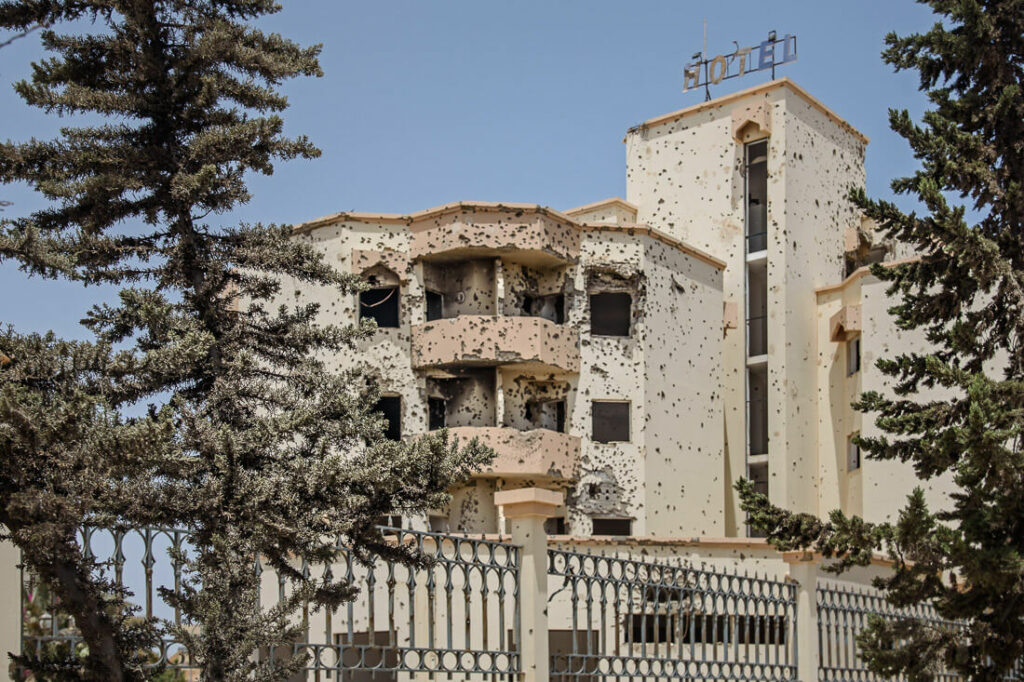
We found this building in Sabratha, an area damaged during the war

How to get a visa for Libya
SUPERUPDATE 2024!
The visa for Libya used to be one of the most difficult ones in the world, a very painful process full of uncertainties.
However, as of April 2024, the Government decided to implement an e-visa system, with which you can obtain your visa in one week.
You can apply for your e-visa here.
e-visa for Libya: FAQ
How much does the e-visa for Libya cost?
It costs 63 US dollars.
How long does the approval take, and how long is it valid for?
For now, the approval comes after 5 working days, approximately.
Once you get the approval, you have 90 days to enter Libya.
Is it 100% reliable?
In Libya, things change all the time, like nowhere else in the world.
Remember that in 2023, the Government also introduced a visa on arrival, which only lasted for 3 months.
According to our contacts in Libya, the e-visa is fully working and travelers are getting into Libya without any issues but the real question is:
Is the e-visa going to stay?
We don’t know, and nobody can’t know, because this is Libya.
Does the e-visa allow you to travel independently?
Theoretically, you can’t travel independently in Libya.
However, travel reports suggest that some travelers have tried to sneak in and our local contacts in Libya informed us that the tourist police are currently working on preventing this.
They fear, nevertheless, that if travelers keep coming without a local sponsor, they will eventually block the e-visa.
How to get a visa for Libya the old way (before the introduction of e-visa)
The following information is irrelevant now, but I prefer to keep it here, especially because the e-visa system could also disappear, meaning that going back to the old way is a possibility, because this is Libya.
This is how you used to get a Libyan visa up to March 2024.
Step 1 – Getting your Letter of Invitation (LOI)
In order to get your visa for Libya, the first thing you need to do is get a Letter of Invitation from an authorized Libya-based company.
Note that Libyan companies won’t issue an LOI unless you book a full tour of Libya with them.
How long do I have to wait to get the LOI?
The problem with Libya is that nothing is official.
They say that LOI are issued in 1 week but sometimes they don’t come until 3 weeks later and sometimes they in just 3 days.
Libya’s bureaucracy is so random.
How long is the LOI valid for?
There’s no official date but rumors say it has a 1-month validity, extendable to 3 months. Again, this is also pretty random.
Step 2 – Getting your actual visa at the embassy
Once your LOI is approved, the next step is visiting the Libyan embassy in your home country or country of residence.
The LOI will come with a 6-digit number, and it’s recommended to call the embassy in advance, telling them about your upcoming visit and the respective number.
I got my visa at the Libyan embassy in Madrid.
They told me to physically go there any day, from Monday to Wednesday, from 10am to 1pm, and these were their requirements:
Passport with more than 6 months validity2 passport photosLetter of InvitationLetter from the company you work for, stating the business reason you want to travel to LibyaOnce they checked that all my documents were correct, they told me to deposit the amount of 60€ in their bank account – which I did at the nearest bank – and come back with the receipt.
When I gave them the receipt, they told me to come back after two hours to collect my visa, that’s it.
That’s for the embassy in Madrid, what about the rest of the embassies?
Requirements are pretty much the same across most embassies but, while some of them require the applicant to be physically there, others allow you to mail them all docs.
Moreover, like in Madrid, some embassies issue your visa within 2 hours, while others might take a few days.
The best way to find out is by calling your nearest embassy.
What if there’s no embassy in your home country?
Then, you can apply from an embassy of your choice, but you need to tell your local sponsor in advance.
How long is the visa valid for?
Up to September 2023, the visa was valid for 1 month, from the moment you collect it and it can’t be extended.
However, now they say that they will extend it to 3 months.

My visa for traveling to Libya

Travel insurance for Libya
Travel insurance for Libya is a real must, especially in times of pandemic, and I strongly recommend IATI Insurance because:One of the very few that covers travel in LibyaThey have many different plans, for all budgets.Covers both short-term trips and 1-year long trips.It covers senior citizens tooReaders of this blog can get a 5% exclusive discountCLICK THROUGH THIS LINK TO GET 5% SPECIAL DISCOUNT

Traveling to Libya as an independent traveler: is it allowed?
Not really, as mentioned in the visa section of this post.
Actually, independent travel in Libya has never been allowed, even during Gaddafi’s rule, and the reason is that, in their eyes, foreigners could always be potential spies.
With the new e-visa, things could have changed but theoretically speaking, here’s what you need to know on independent travel in Libya.
Your local guide must pick you up from immigration
Nowadays, upon arrival at the International Airport of Tripoli, even before getting your entry stamp, the authorities will put you aside, waiting for your sponsor, a representative from the company who issued your LOI – the local guide, in my case.
This person will have to go through a few formalities and only then, will you be able to enter Libya.
You will be accompanied by a local official
During my trip to Libya, I had always to be accompanied by an official who claimed to be part of the tourist police.
Along with my local guide and driver, this person stuck with us the whole time, eating with us and even staying in our hotels outside of Tripoli.
While spending the whole trip with an official might seem quite annoying – you actually have to pay for his meals and hotels – but that’s included in the total tour package – the truth is that he was a pretty nice guy who basically became one more of us.
He was unarmed, joked all the time and always tried to be helpful.
Some travelers who travel to Libya as gas consultants (fake purpose, of course) claim that they were never accompanied by such an official, but only the local guide.Your itinerary can’t be flexible
It can’t be changed. Your itinerary will be shared with the security department before your arrival and making changes won’t be allowed.
Can you walk around Tripoli on your own
Yes, you can but this is something you must discuss with your local guide.
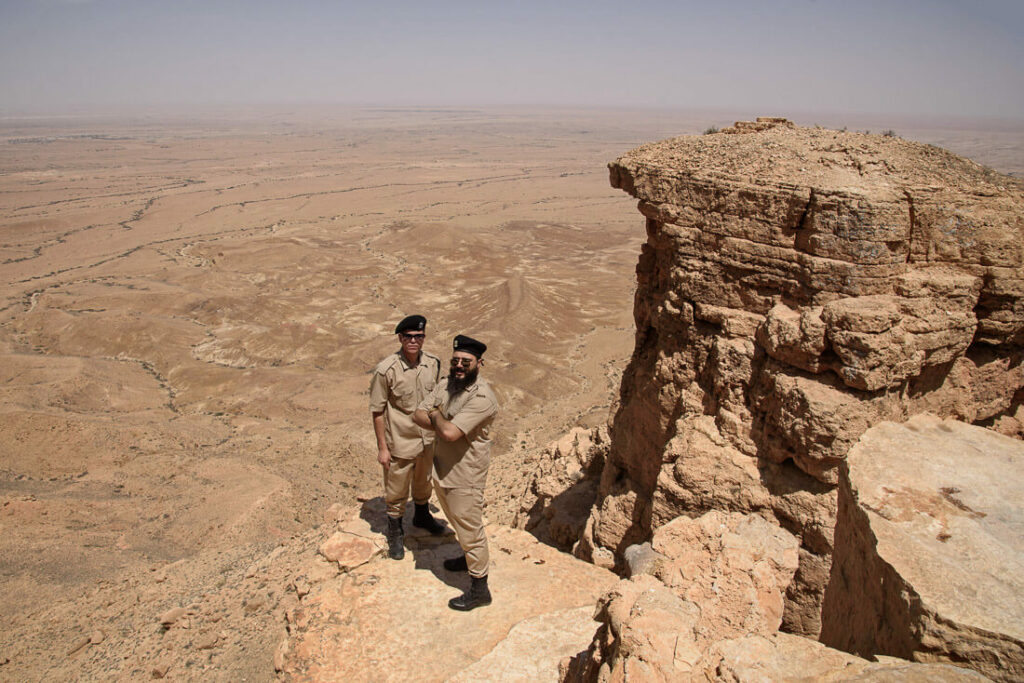
Two men from the tourist police who joined us for a few hours

Tours for Libya
Independent travel in Libya is not possible nowadays.Against the Compass, however, runs tours into Libya.
Our next scheduled tour for Libya is in:
October 26th to November 1st, 2024 – APPLY NOW
January 30th to February 7th, 2025 – APPLY NOW
Learn more about our Libya tours

Best time to visit Libya
Best time to travel to Libya: November to March
The weather becomes pleasant during these months but note that temperature can drop to 0ºC in December-January, so do bring warm clothing for the freezing nights, especially in the desert areas.
Worst time to travel to Libya: June to September
In summer, Libya is too hot to enjoy.
I personally came during the last week of May and days were already utterly hot, making sightseeing very difficult. Evenings however, were good.
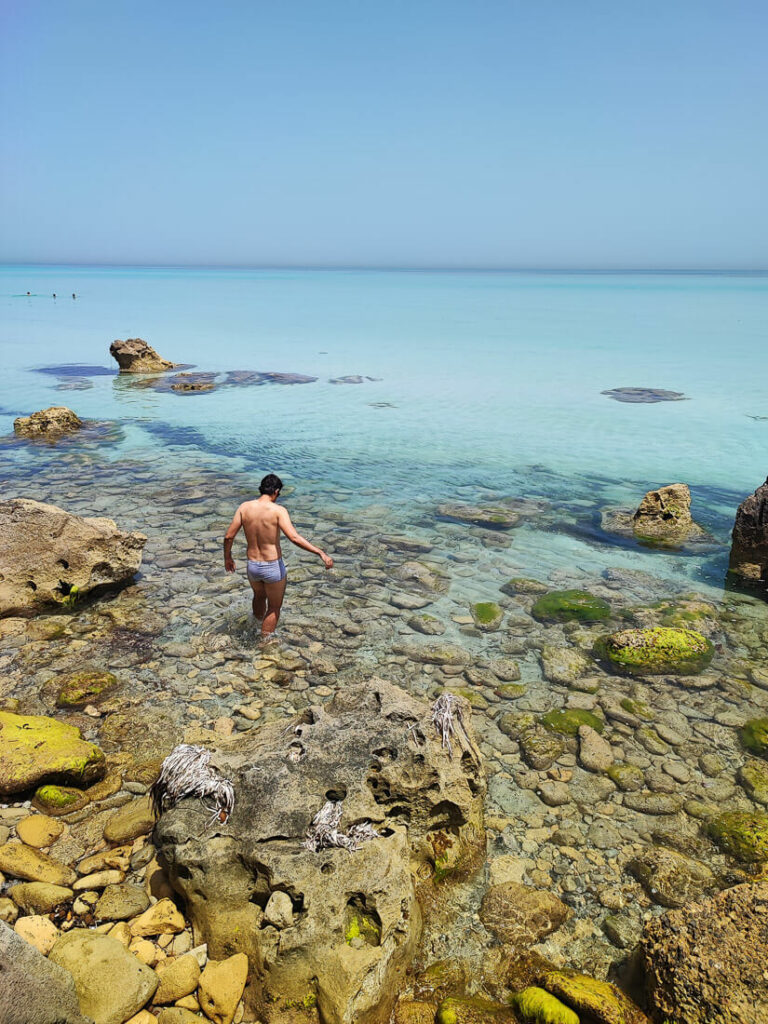
The coast of Libya is outstanding, pure Mediterranean

How to get to Libya
How to travel to Libya by air
The main airport in Libya is Mitiga International Airport, located 11km from the center of Tripoli.
This airport used to have plenty of connections but nowadays, you can only travel from the following cities:
TunisCairoIstanbulI recommend coming from Tunis because there are a lot more flights, plus they are cheaper.
Which airlines fly to Libya?
Today, the only foreign airline that flies to Tripoli is Tunis Air but the problem is that it doesn’t fly there every day, only 2-3 times a week, so depending on your travel dates, it could be inconvenient.
Alternatively, Libyan Wings flies from Tunis to Tripoli every day but the problem is that you can’t book tickets online, so someone has to go to an actual Libyan Wings office and pay in cash. This is something you’ll need to arrange with your local guide or sponsor.
How to travel to Libya by land:
Libya shares a border with 5 countries.
Traveling to Libya from Tunisia
Travel reports suggest the border is open, and there are actually direct buses from Tunis to Tripoli but, besides the nearly 800km distance, border formalities will take a lot of time if you go on a bus packed with people.
Alternatively, you could head slowly to the border (the one by the coast) and cross on foot. However, if you opt for this choice, your local guide will have to pick you up from there, increasing the overall cost of your trip.
Check my Tunisia travel guide
Traveling to Libya from Egypt
This border used to be open during Gaddafi’s time but not anymore, since the Eastern part of Libya is controlled by a different faction that won’t recognize your business visa.
Check my Egypt travel guide
Traveling to Libya from Algeria, Niger, Chad and Sudan
Those borders are super closed.
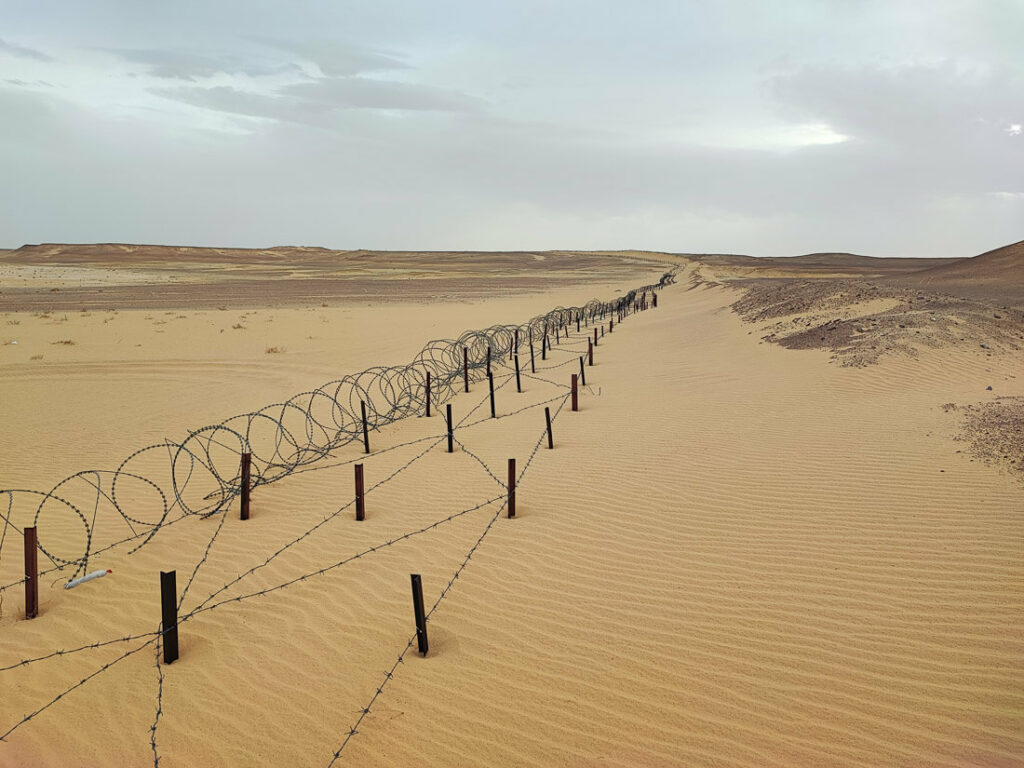
The Libyan-Algerian border. If you wanted to travel to Libya from Algeria by road, know that this border is closed to foreigners
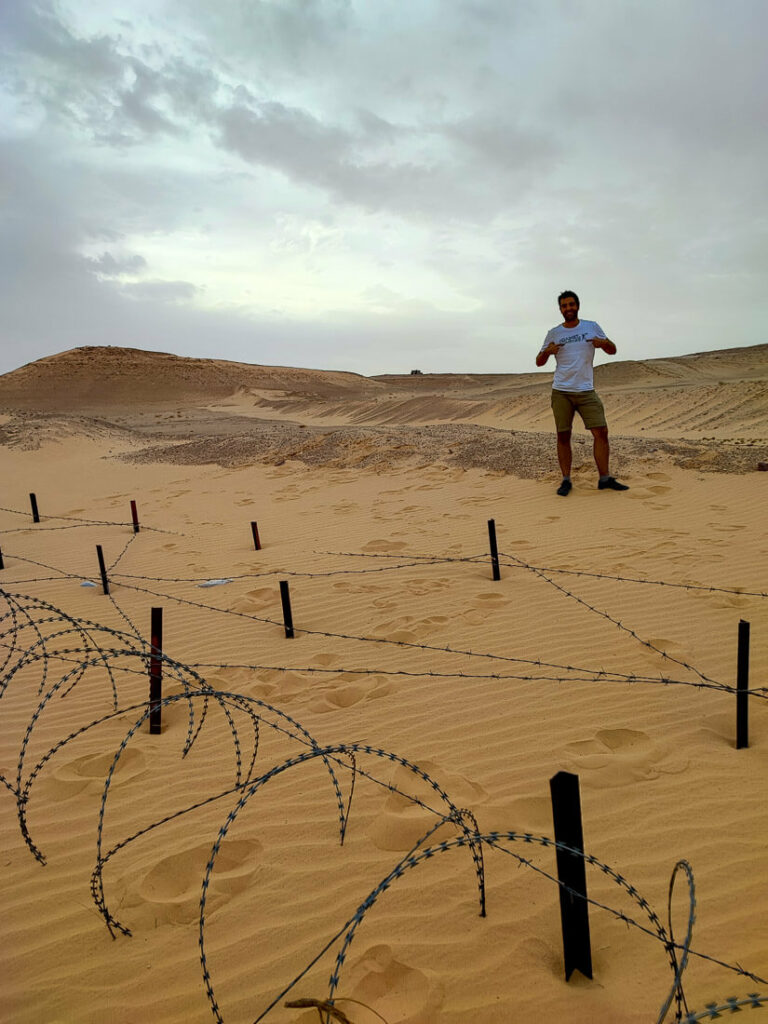
Which side am I?

Top experiences in Libya
Libya has actually a lot of touristic potential; it is no wonder that during the Gaddafi years, many tour groups used to come here.
1 – Visiting first-league Roman ruins
Leptis Magna and Sabratha are exceptional Roman sites, with no reason to envy Palmyra in Syria, or Baalbek in Lebanon, and the best thing about them is that they are built by the sea.
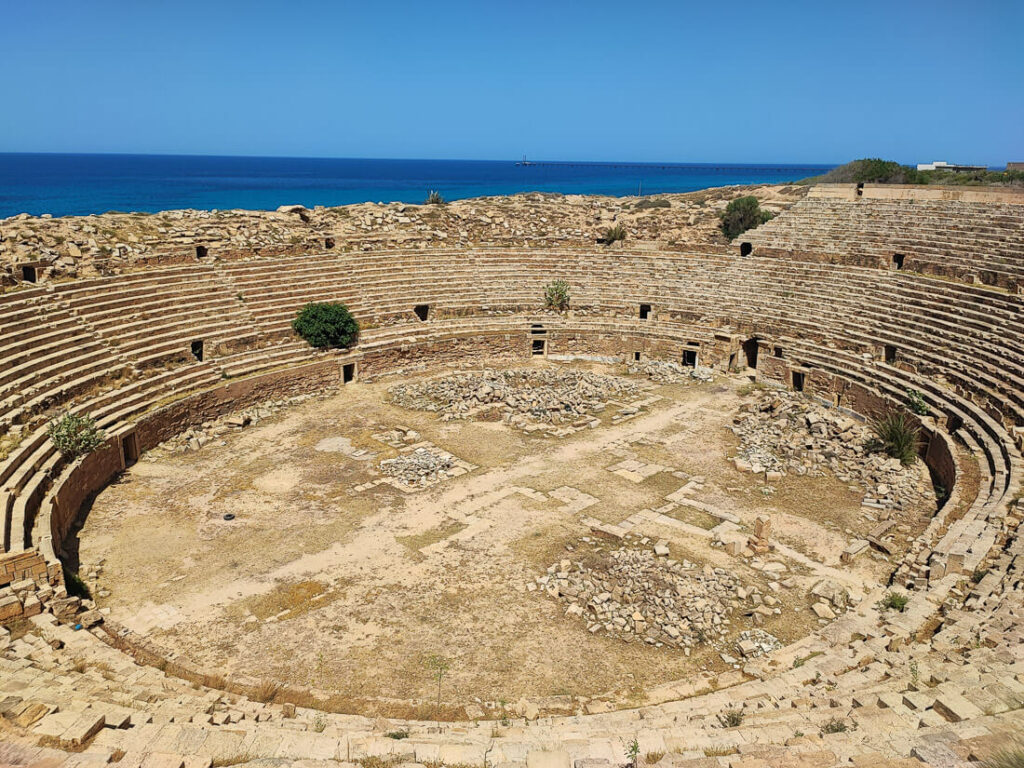
An epic amphitheater by the Mediterranean sea, one of the best things to check during your Libya trip
2 – Admiring the Italian Heritage in Tripoli
As in Eritrea, Italians left their footprint in Libya, leaving behind a very strong coffee culture and the most beautiful buildings in the country.
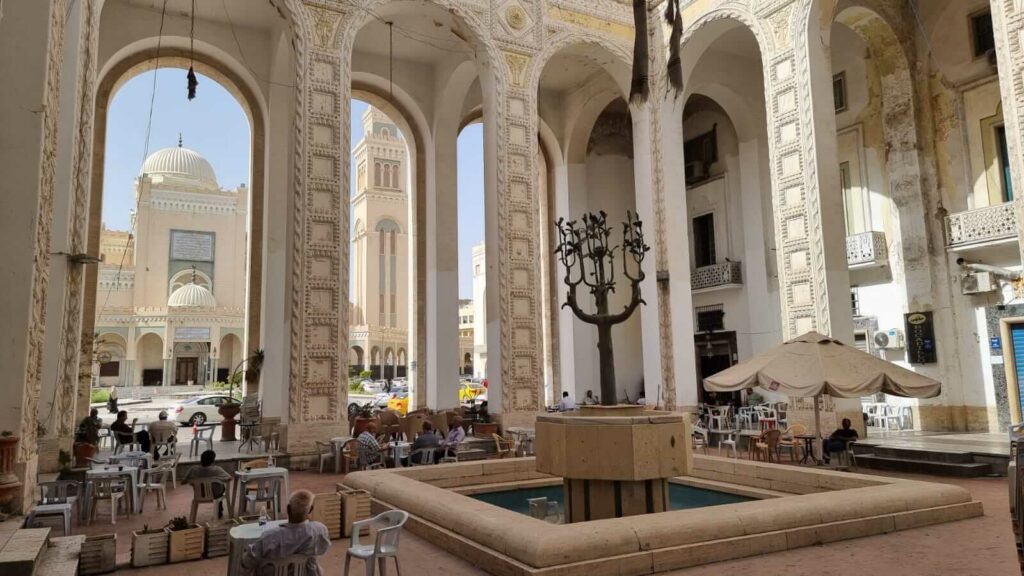
An Italian café in the center of Tripoli
3 – Experiencing the Libyan desert
Whether you are driving from town to town, or just having tea with the Tuaregs, few countries in the world have such a vast, empty desert.
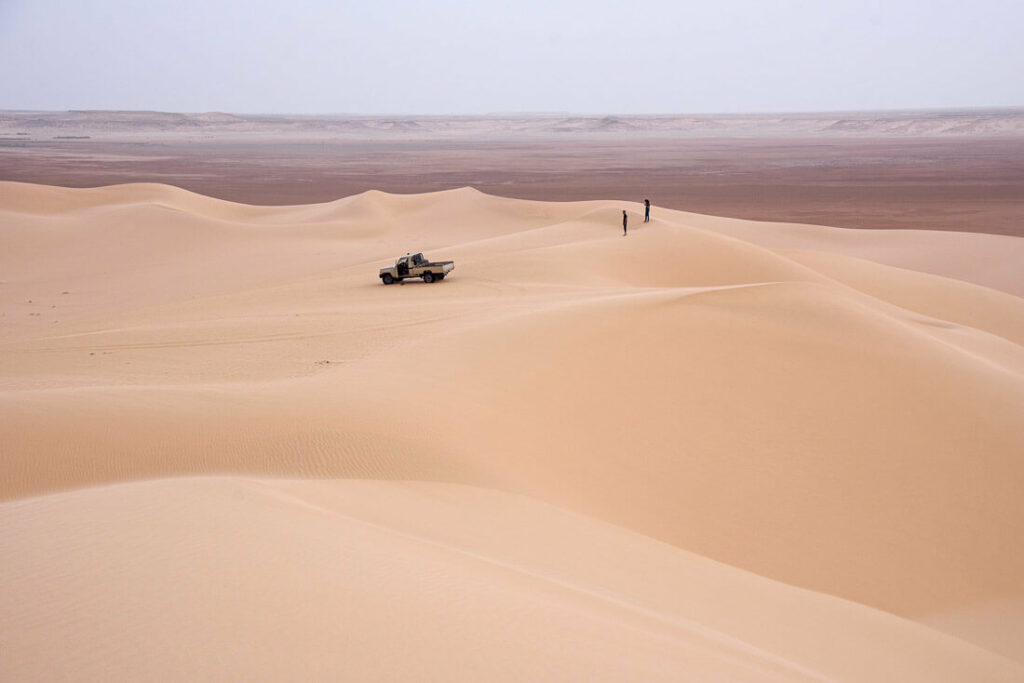
The Libyan desert, less than 1-kilometer away from the Algerian border
4 – Visiting the ancient caravan city of Ghadames
Ghadames is an ancient desert town and oasis, home to an entangled and massive old city composed of hundreds of pathways, which also turns out to be a UNESCO Heritage site.
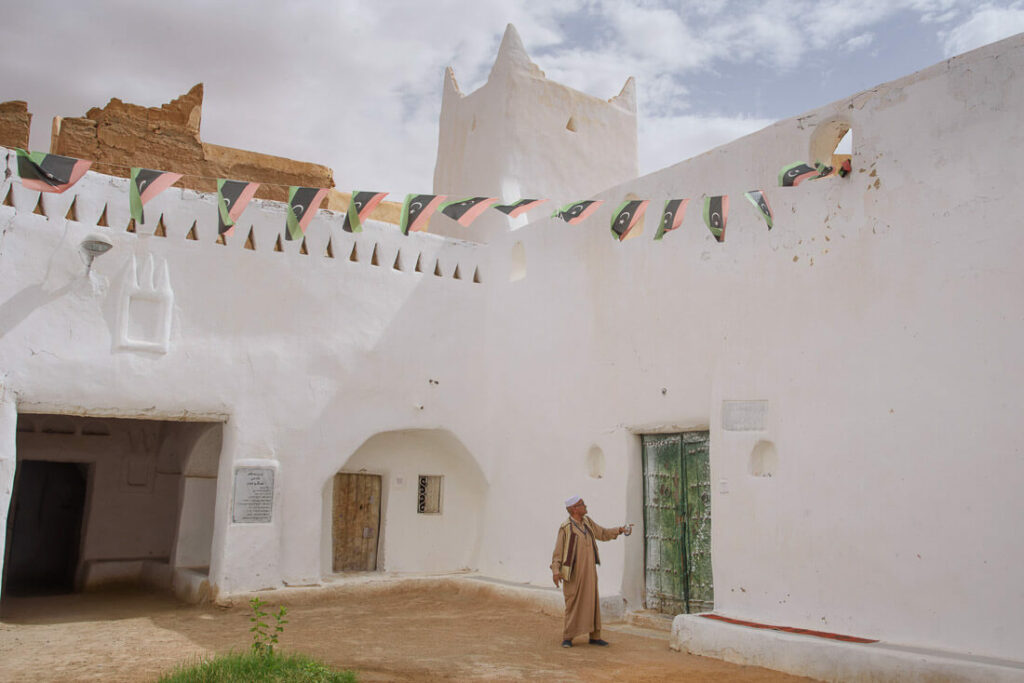
The Old Town of Gadhames
5 – Learning about the current crisis in Misrata
Misrata was one of the most affected cities during the Libyan Civil war, the legacy of which is still very visible. Today, the city features a brand-new museum about the crisis.
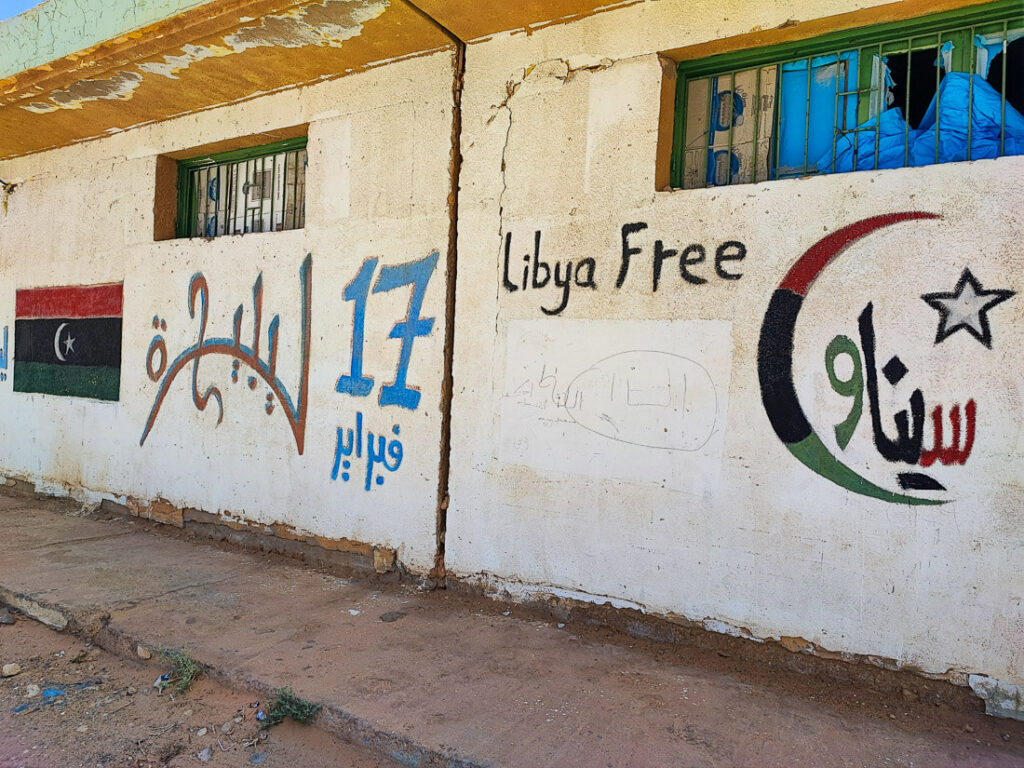

Internet and connectivity in Libya
As expected, Wi-Fi isn’t particularly reliable in Libya, but you can easily get a local SIM card at the airport.
I personally bought a SIM card packed with 20GB of data for just 39LYD (around 8 USD), which was more than enough for just 6 days.
Get a VPN for traveling in Libya
You should always use a VPN when you travel, especially when you connect to public Wi-Fi networks.Your connection will be much safer. Moreover, you will be able to access content which is typically censored in Libya. I recommend ExpressVPN – Extremely easy to use, fast and cheap. Get a vpnIf you want to learn more about VPN, check: Why you need a VPN for traveling.

Budget and money: how much does it cost to travel to Libya?
In Libya, they use the Libyan Dinar (LYD) and approximately:
1 USD = 4.80 LYDObviously, the currency in Libya is not very stable, so do check the exact exchange rate before departure.
Can you use credit or debit cards in Libya?
No, you can’t, so do bring all your money in cash.
However, you won’t need much money because you are likely to travel to Libya on a tour, where pretty much everything is included.
In 6 days, I spent the equivalent of 30€, just for a few night meals which weren’t included in Tripoli.
Where can I exchange money?
I believe your local guide will help you with that but the main area for exchange is in a specific place in the old city of Tripoli.
How much does it cost to travel to Libya?
As mentioned, the only way to travel to Libya is by purchasing a tour, which tends to include all expenses but in any case, here’s a summary of the most typical costs:
Visa: around 65 USDRound trip flight Tunis Tripoli with Libyan Wings: €250Meal in a local restaurant: around 25-40 LYDMeal in a fancy restaurant: from 50-90LYDEspresso or cappuccino in a local coffee shop: 2 LYDEspresso or cappuccino in a fancy café: 5 LYD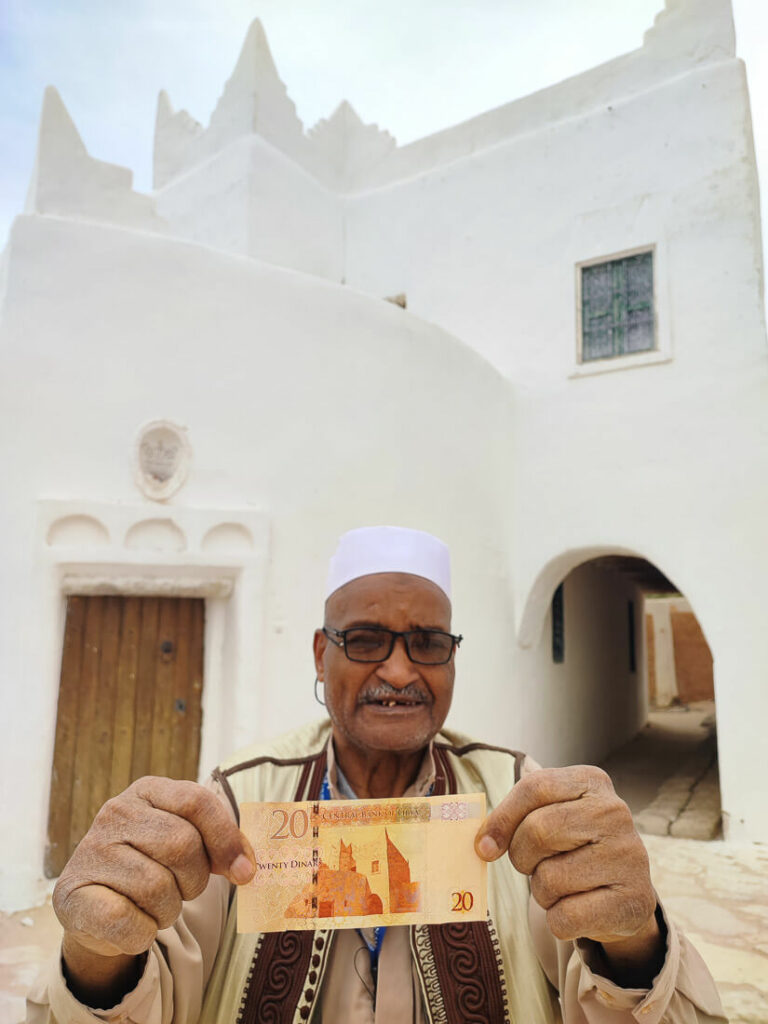
The 20-dinar note features one of the buildings from Gadhames

How to get around Libya
It doesn’t really make sense to add a getting around section since you’ll be traveling from city to city by car, with your local guide but still, here are a few things to keep in mind:
Gas is extremely cheap, the second cheapest in the world after Venezuela.Despite having some of the most massive oil reserves, there’s an oil shortage, and many gas stations are virtually empty. On our way to Ghadames, we had to travel with three large cans filled with gas, since finding gas can be a gamble.The driving is bad, Libyans don’t really like to follow traffic rules, but that didn’t surprise me.The coastal road is sort of busy, but the roads leading inland are absolutely empty, only desert, and barely any cars.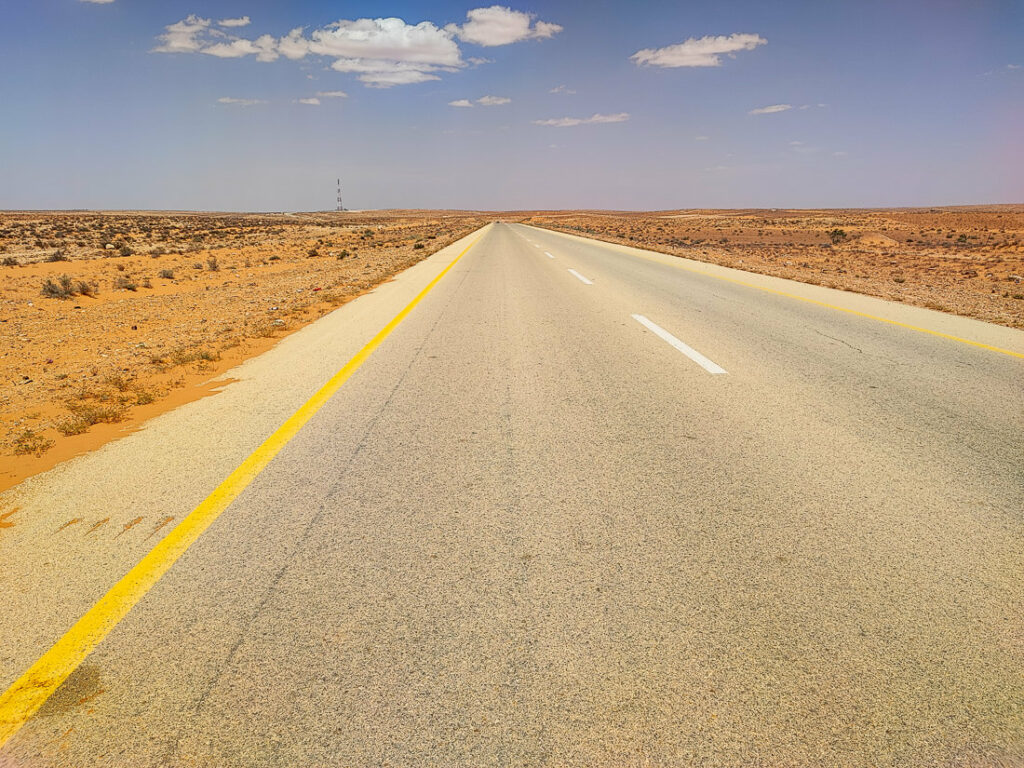
Roads in Libya, on the way to Gadhames

Libya: the country, people and culture
Along with Morocco, Mauritania, Tunisia and Algeria, Libya is one of the 5 countries that compose the Maghreb region.
It is the 4th largest country in Africa, and the 16th in the world, but its land is only inhabited by 6 million people, making it one of the least densely populated countries in the world.
People, the Libyans
Unlike other African countries, Libya has a pretty homogenous society.
Arabs: Most Libyans can be classified as Arabs. However, while the western part of Libya has more similarities to Morocco, Algeria and Tunisia, the eastern part has more resemblance to Egypt. In fact, this cultural difference is what has left the country divided, and dictates the international agenda too, since both Governments are supported by their respective foreign counterpart.

Having lunch with my team
Berbers: Apparently, 5% of the total Libyan population are Berbers, the indigenous ethnic group in north Africa before the Arabs came. They have their own language and folklore, and usually, they have a darker skin. I found Berbers from Libya had a stronger identity than Berbers in Tunisia or Morocco, since Berber flags were seen everywhere. However, they have absolutely no problem in saying they are Libyans. On the way to Ghadames, you’ll see lots of Berber towns.
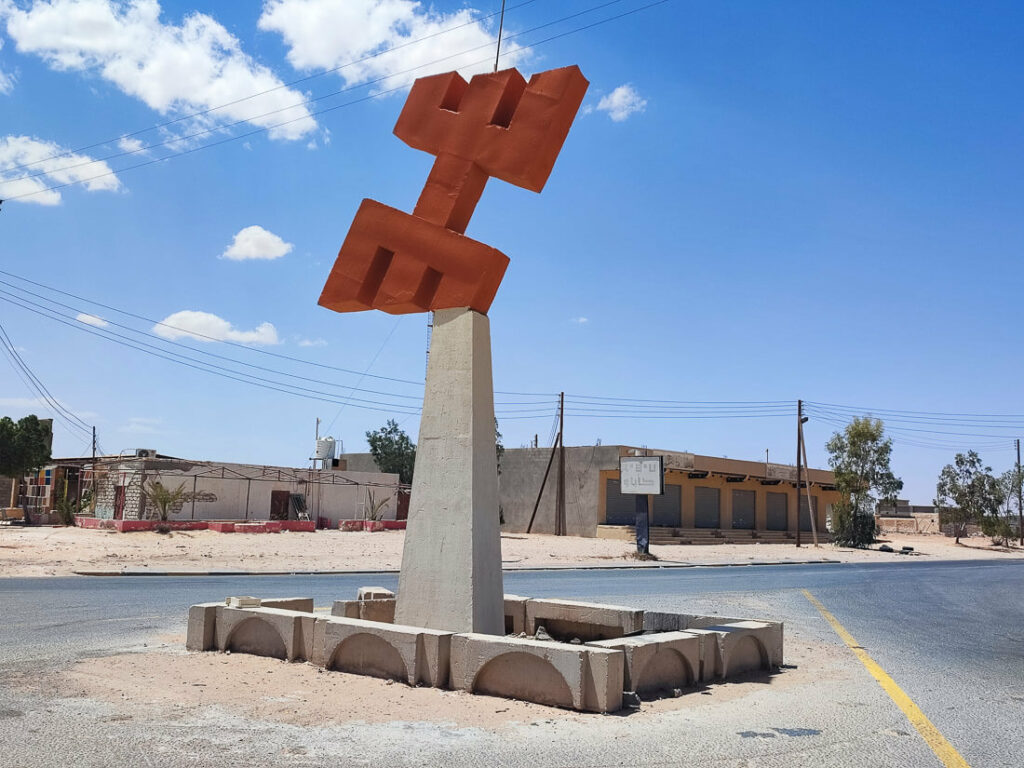
The Berber emblem, visible in all predominantly Berber areas
Language
In Libya, they speak Arabic and, like its people, while the dialect spoken in West Libya is similar to Tunisia’s, in East Libya it is similar to Egypt’s.
Do people speak English in Libya?
Not much but again, you are likely to be with a local guide the whole time, so communication shouldn’t be much of an issue.
Religion
Libyans are Sunni Muslims, but in Tripoli, you can find some churches that are frequented by the small Christian community.
Like Bashar al Assad in Syria, Muammar Gaddafi was a secular dictator who always condemned fundamentalist and religious extremists but unlike in Syria, where there’s a very significant secular society, I found the people in Libya to be extremely religious and traditional.
The few women you see in the street always wear hijab and to my surprise, many of them wore the niqab, something rarely seen in North Africa.

Local women visiting Leptis and Magna

Libyan cuisine
Food won’t be the highlight of your trip, but some of their dishes aren’t bad.
I can’t tell what’s food like in East Libya, but in West Libya, food is similar to other countries in the Maghreb.
Cous-cous is their signature meal and what I like about it is that it’s quite juicy, usually tomato-based, like in Tunisia, while in Morocco I always found it to be drier. Grilled meat with white rice is always available in most restaurants and, thanks to the Italian influence, pasta too.
In Tripoli, you can actually find many Italian restaurants, a very popular chain being Caffe di Roma, where you have a wide variety of pastas and pizzas to choose from. It’s not the best pasta ever but after a few days of just eating cous-cous, it wasn’t bad at all.
Another dish I tried was usban, a Libyan sausage filled with rice and meat, too heavy for my taste, but sort of tasty.
lcohol in LibyaSince Gaddafi came into power in 1969, Libya has been a dry country.
Being such a secular ruler, I wondered why he banned alcohol. Some Libyans believe he banned it so people would not get drunk and start talking about politics, saying bad things about the Government. That’s hard to believe, since not even Kim Jong Un does that.
Coffee in Libya
I am a big coffee drinker, especially in the morning, so whenever I visit a predominantly tea country, I always struggle, and I thought Libya would be one of those, but I was wrong.
Coffee culture in Libya is a big deal and, due to the Italian influence, they prepare it in a pretty sophisticated way, with so much love, and always with the right amount of foam.
What was even more surprising, however, is that you can also have really good coffee in more rural towns, like Ghadames for example, and even in the random villages you find along the road.

Libyan cous-cous

Where to stay in Libya
There aren’t many hotels in Libya, but there are enough to accommodate the few tourists, business people, and diplomats that visit the country.
Where to stay in Tripoli
Mid-range – Hotel Victoria – This is the preferred hotel for travelers, featuring a rooftop with excellent views to the city.
5 stars – Sheraton Hotel – Better than Victoria, of course.
Top-end – Corinthia Hotel Tripoli – The best hotel in town
Where to stay outside of Tripoli
In Gadhames: we stayed at Ghadamis Hotel, a massive hotel with traditional architecture that opened 1 or 2 years before the beginning of the war but, since it’s government-owned, it has remained open. We stayed there for two nights, and were completely alone.
In Misrata: With our groups, we used to stay in Safari Hotel
In Al Baida: Al Baida is the base for exploring East Libya, and the hotel we stay is Hotel Marhaba
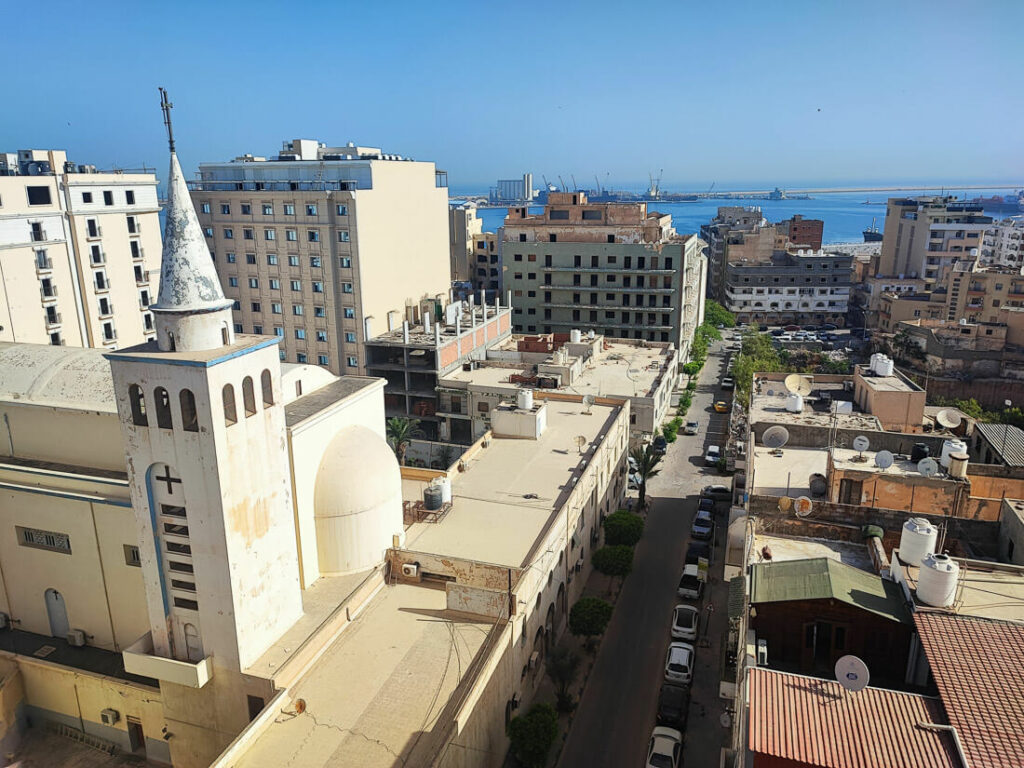
Views from Victoria Hotel

Solo female travel in Libya
Independent travel is not allowed in Libya, so solo women will always go with the local guide and the tourist police, making things much easier for them.
My local guide said he has had many female clients – some of them came alone, while others with a partner or friend – and he said all of them had a great time.
Have you been to Libya (as a solo female) and want to write a guest post for Against the Compass to tell us about the experience?
Then, kindly shoot me an email at [email protected]

More Information for traveling to Libya

In my Travel Resources Page you can find the list of all the sites and services I use to book hotels, tours, travel insurance and more.
Travel guides to other countries in Africa
Ethiopia Travel GuideEritrea Travel GuideSomaliland Travel GuideTravel Guide to SudanTravel Guide to EgyptMali Travel GuideTravel Guide to MauritaniaTunisia Travel GuideYou will also like our Syria travel guideIraq travel guide and Haiti travel guide.

-
By: Joan Torres
Title: How to Travel to Libya in 2024
Sourced From: againstthecompass.com/en/travel-libya/
Published Date: Tue, 30 Apr 2024 03:41:00 +0000
Did you miss our previous article...
https://onebagtravel.club/how-to/matilda-the-musical-is-coming-to-bangkok-for-the-very-first-time











